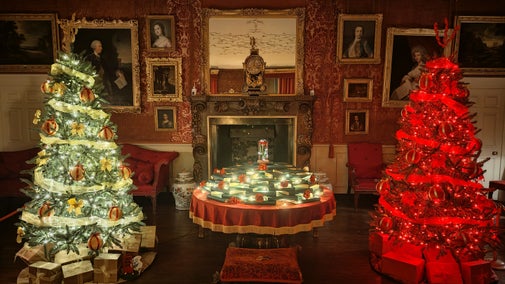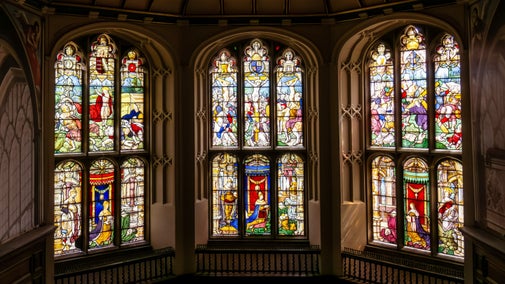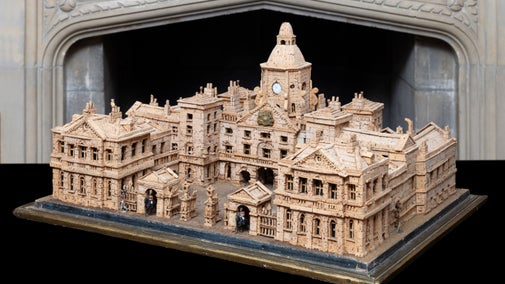
The Vyne's collections
Explore the objects and works of art we care for at The Vyne on the National Trust Collections website.

An 18th century school boy’s doodle of a cyclops is just one of the tiny observations methodically catalogued by the collections and care team. It formed part of the work to return the entire historic library collection back to its shelves following a major £5.4 million roof project.
During the roof project the books were packed up and held in conservation storage. All the books have now been individually checked for pests, mould and physical damage. They were then photographed and cleaned before being returned to the library shelves.
Cataloguing the entire library collection gave a wonderful opportunity to record centuries-old margin scribblings, pictures and personal letters. The work has enabled these annotations and drawings to be recorded for ever and will now form part of the library catalogue.
– Dominique Shembry, Senior Collections & House Officer
There are a wide variety of books ranging in topics from theology and history to languages. Novels include those by Jane Austen who was a friend of Thomas Chute. A total of 2,419 books are held in the collection with many amassed by the Chute family over 300 years.
William Wiggett Chute’s determination to save the house from decay has helped form the immense collection. He built the library from recycled wood and furniture where he could in order to save money. Some of the interesting decoration comes from the family pew in the local church and he even took pieces from other rooms in the house too.

The book of Ancient Greek drama was written in Latin and published in 1771. It belonged to 15-year-old William John Chute, who lived at The Vyne between 1757 and 1824. This book held a hidden drawing of a cyclops and could possibly have been drawn by William.
Found inside the book Practical measuring made easy to the meanest capacity by a new set of tables were sketches of windows for The Vyne’s towers. These drawings were accompanied by complicated calculations made by owner Anthony Chute in 1746.
We believe he may have written in the book when he was making improvements to the house. Anthony must have used the book to help him take the measurements required for the improvements to the house.

The oldest book in the library is a 15th-century Book of Hours written in Dutch and possibly originates from Delft. This small book has a stamped leather binding with a brass clasp. The mid-brown exterior hides colourful and vibrant pages. The start of each hour is decorated with an initial painted with a blue background and gold overpaint.
The entire project was carried out in front of visitors so that discoveries could be shared as they were uncovered by the team. All drawings and annotations will be carefully recorded and available to researchers in the future.

Explore the objects and works of art we care for at The Vyne on the National Trust Collections website.
Until 5 January 11am-3pm, immerse yourselves in the magic of best-loved fairy tales. Explore the ground floor of the house aglow with sparkling Christmas trees and atmospheric lighting. There are eight stories to discover. Free with usual admission. Collect timed tickets for house on arrival - no pre-booking. The Sandys and Chute families made The Vyne their home for over 500 years. They accumulated beautiful and important objects and made significant changes to the house during their lives. Come back after Christmas to enjoy the collection in opulent state rooms and humble servants’ quarters. Read on for more information.

The Vyne was once one of the most important Tudor houses in Hampshire. For over 500 years, it was owned and shaped by just two families, the Sandys and the Chutes. Each generation enriched the property, resulting in an incredible collection and range of architecture and interiors, demonstrating the highest quality in design and craftsmanship.

Discover what to see and do in the garden all year round at The Vyne. Explore the historic summerhouse, see what’s growing in the walled garden and take a walk by the lake.

Find out about volunteering with the team at The Vyne. Currently recruiting for a range of opportunities across the house and estate, find out how you could help protect this special place.

Discover the stories behind some of the greatest artworks and artefacts looked after by the National Trust, as told in a dedicated book, 125 Treasures from the Collections of the National Trust.

See the breadth of our collection of works of art, furniture and more: we care for around a million objects at over 200 historic places, there’s a surprise discovery around every corner.

The art and heritage collections we care for rival the world’s greatest museums. Learn more about the collection of paintings, decorative art, costume, books, household and other objects at historic places.
